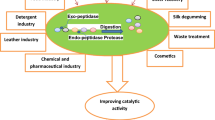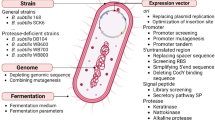Abstract
Alternative splicing plays an important role in expanding protein diversity. In the present study, different splice variants of the antitrypsin gene (sw-AT) in the silkworm were identified by bioinformatics analyses using expressed sequence tags and genomic information. Four splice variants were obtained by RT-PCR with suitably designed primers, confirmed by sequencing, and designated as sw-AT-1, sw-AT-2, sw-AT-3, and sw-AT-4. The sw-AT gene contains 10 exons and nine introns. The splice variants differ in exon 9, with sw-AT-1, sw-AT-2, and sw-AT-3 using different versions of the exon, namely exon 9a, 9b, and 9c, respectively. In sw-AT-4, exon 9 consists of the combination of exons 9b and 9c. The expression patterns of the four isoforms in different tissues, at different developmental stages, and under different stress conditions (temperature, starvation, and mycotic infection) were characterized and quantified. The sw-AT isoforms showed tissue-specific expression patterns, with sw-AT-1 present in almost all tissues and sw-AT-4 found in only a few tissues. The four isoforms were predominantly expressed in the fat body, body wall, and testes of larvae, and exhibited similar expression profiles during development of the fat body. Among the stress treatments, low temperature had the greatest effect on isoform expression, and expression was also upregulated with mycotic infection.





Similar content being viewed by others
References
Gilbert W (1978) Why genes in pieces? Nature 271:501
Lopez AJ (1998) Alternative splicing of pre-mRNA: developmental consequences and mechanisms of regulation. Annu Rev Genet 32:279–305. doi:10.1146/annurev.genet.32.1.279
Black DL (2003) Mechanisms of alternative pre-messenger RNA splicing. Annu Rev Biochem 72:291–336. doi:10.1146/annurev.biochem.72.121801.161720
Kan Z, Rouchka EC, Gish WR, States DJ (2001) Gene structure prediction and alternative splicing analysis using genomically aligned ESTs. Genome Res 11:889–900. doi:10.1101/gr.155001
Modrek B, Resch A, Grasso C, Lee C (2001) Genome-wide detection of alternative splicing in expressed sequences of human genes. Nucleic Acids Res 29:2850–2859
Kriventseva EV, Koch I, Apweiler R, Vingron M, Bork P, Gelfand MS, Sunyaev S (2003) Increase of functional diversity by alternative splicing. Trends Genet 19:124–128. doi:10.1016-9525(03)00023-4
Chan WY, Soloviev MM, Ciruela F, McIlhinney RA (2001) Molecular determinants of metabotropic glutamate receptor 1B trafficking. Mol Cell Neurosci 17:577–588. doi:10.1006/mcne.2001.0965
Nardi JB (1995) Molecular model systems in the lepidoptera. Science 269:1743. doi:10.1126/science.269.5231.1743
Couble P, Michaille JJ, Garel A, Couble ML, Prudhomme JC (1987) Developmental switches of sericin mRNA splicing in individual cells of Bombyx mori silkgland. Dev Biol 124:431–440. doi:10.1016/0012-1606(87)90496-9
Suzuki MG, Ohbayashi F, Mita K, Shimada T (2001) The mechanism of sex-specific splicing at the doublesex gene is different between Drosophila melanogaster and Bombyx mori. Insect Biochem Mol Biol 31:1201–1211. doi:10.1016/S0965-1748(01)00067.4
Abdel-Banat BM, Koga D (2002) Alternative splicing of the primary transcript generates heterogeneity within the products of the gene for Bombyx mori chitinase. J Biol Chem 277:30524–30534. doi:10.1074/jbc.M112422200
Niu BL, Meng ZQ, Tao YZ, Lu SL, Weng HB, He LH, Shen WF (2005) Cloning and alternative splicing analysis of Bombyx mori transformer-2 gene using silkworm EST database. Acta Biochim Biophys Sin (Shanghai) 37:728–736. doi:10.1111/j.1745-7270.2005.00106.x
Wang ZL, Li J, Xia QY, Zhao P, Duan J, Zha XF, Xiang ZH (2005) Identification and expression pattern of Bmlark, a homolog of the Drosophila gene lark in Bombyx mori. DNA Seq 16:224–229. doi:10.1080/10425170500129652
Gopalapillai R, Kadono-Okuda K, Tsuchida K, Yamamoto K, Nohata J, Ajimura M, Mita K (2006) Lipophorin receptor of Bombyx mori: cDNA cloning, genomic structure, alternative splicing, and isolation of a new isoform. J Lipid Res 47:1005–1013. doi:10.1194/jlr.M500462-JLR200
Shao YM, Dong K, Zhang CX (2007) The nicotinic acetylcholine receptor gene family of the silkworm, Bombyx mori. BMC Genomics 8:324. doi:10.1186/1471-2164-8-324
Neurath H (1999) Proteolytic enzymes, past and future. Proc Natl Acad Sci USA 96:10962–10963
LeMosy EK, Hong CC, Hashimoto C (1999) Signal transduction by a protease cascade. Trends Cell Biol 9:102–107. doi:10.1016/S0962-8924(98)01494-9
Jiang H, Kanost MR (2000) The clip-domain family of serine proteinases in arthropods. Insect Biochem Mol Biol 30:95–105. doi:10.1016/S0965-1748(99)00113-7
Liu CT, Hou RF, Ashida M, Chen CC (1997) Effects of inhibitors of serine protease, phenoloxidase and dopa decarboxylase on the melanization of Dirofilaria immitis microfilariae with Armigeres subalbatus haemolymph in vitro. Parasitology 115:57–68
Krem MM, Di Cera E (2002) Evolution of enzyme cascades from embryonic development to blood coagulation. Trends Biochem Sci 27:67–74. doi:10.1016/S0968-0004(01)02007-2
Jiang H, Wang Y, Kanost MR (1994) Mutually exclusive exon use and reactive center diversity in insect serpins. J Biol Chem 269:55–58
Jiang H, Wang Y, Huang Y, Mulnix AB, Kadel J, Cole K, Kanost MR (1996) Organization of serpin gene-1 from Manduca sexta. Evolution of a family of alternate exons encoding the reactive site loop. J Biol Chem 271:28017–28023. doi:10.1074/jbc.271.45.28017
Hashimoto C, Kim DR, Weiss LA, Miller JW, Morisato D (2003) Spatial regulation of developmental signaling by a serpin. Dev Cell 5:945–950. doi:10.1016/S1534-5807(03)00338-1
Abraham EG, Pinto SB, Ghosh A, Vanlandingham DL, Budd A, Higgs S, Kafatos FC, Jacobs-Lorena M, Michel K (2005) An immune-responsive serpin, SRPN6, mediates mosquito defense against malaria parasites. Proc Natl Acad Sci USA 102:16327–16332. doi:10.1073/pnas.0508335102
Takagi H, Narumi H, Nakamura K, Sasaki T (1990) Amino acid sequence of silkworm (Bombyx mori) hemolymph antitrypsin deduced from its cDNA nucleotide sequence: confirmation of its homology with serpins. J Biochem 108:372–378
Zou Z, Picheng Z, Weng H, Mita K, Jiang H (2009) A comparative analysis of serpin genes in the silkworm genome. Genomics 93:367–375
Hongsheng L (1991) The sericultural science in China. Shanghai Scientific and Technical Publishers, Shanghai
McKeown M (1992) Alternative mRNA splicing. Annu Rev Cell Biol 8:133–155. doi:10.1146/annurev.cb.08.110192.001025
Shigematsu H (1958) Synthesis of blood protein by the fat body in the silkworm, Bombyx mori L. Nature 182:880–882
Xu Y, Xu J, Kawa saki Hideki (2000) Studies on changes of protein synthesis in fat body of silkworm (Bombyx mori). Acta Sericologica Sinica 26:239–243
Tong Y, Kanost MR (2005) Manduca sexta serpin-4 and serpin-5 inhibit the prophenol oxidase activation pathway: cDNA cloning, protein expression, and characterization. J Biol Chem 280:14923–14931. doi:10.1074/jbc.M500531200
Tanaka H, Ishibashi J, Fujita K, Nakajima Y, Sagisaka A, Tomimoto K, Suzuki N, Yoshiyama M, Kaneko Y, Iwasaki T, Sunagawa T, Yamaji K, Asaoka A, Mita K, Yamakawa M (2008) A genome-wide analysis of genes and gene families involved in innate immunity of Bombyx mori. Insect Biochem Mol Biol 38:1087–1110. doi:10.1016/j.ibmb.2008.09.001
Acknowledgments
This work was supported by grants from the National Natural Sciences Foundation of China (30770279) and the National High Technology Research and Development Program of China (“863” Project No. 2006AA10A119).
Author information
Authors and Affiliations
Corresponding author
Electronic supplementary material
Below is the link to the electronic supplementary material.
Rights and permissions
About this article
Cite this article
Liu, Hf., Li, Yn., Jia, R. et al. Alternative splicing of the antitrypsin gene in the silkworm, Bombyx mori . Mol Biol Rep 38, 2793–2799 (2011). https://doi.org/10.1007/s11033-010-0424-4
Received:
Accepted:
Published:
Issue Date:
DOI: https://doi.org/10.1007/s11033-010-0424-4




